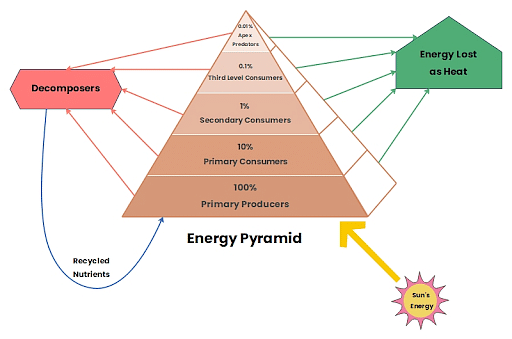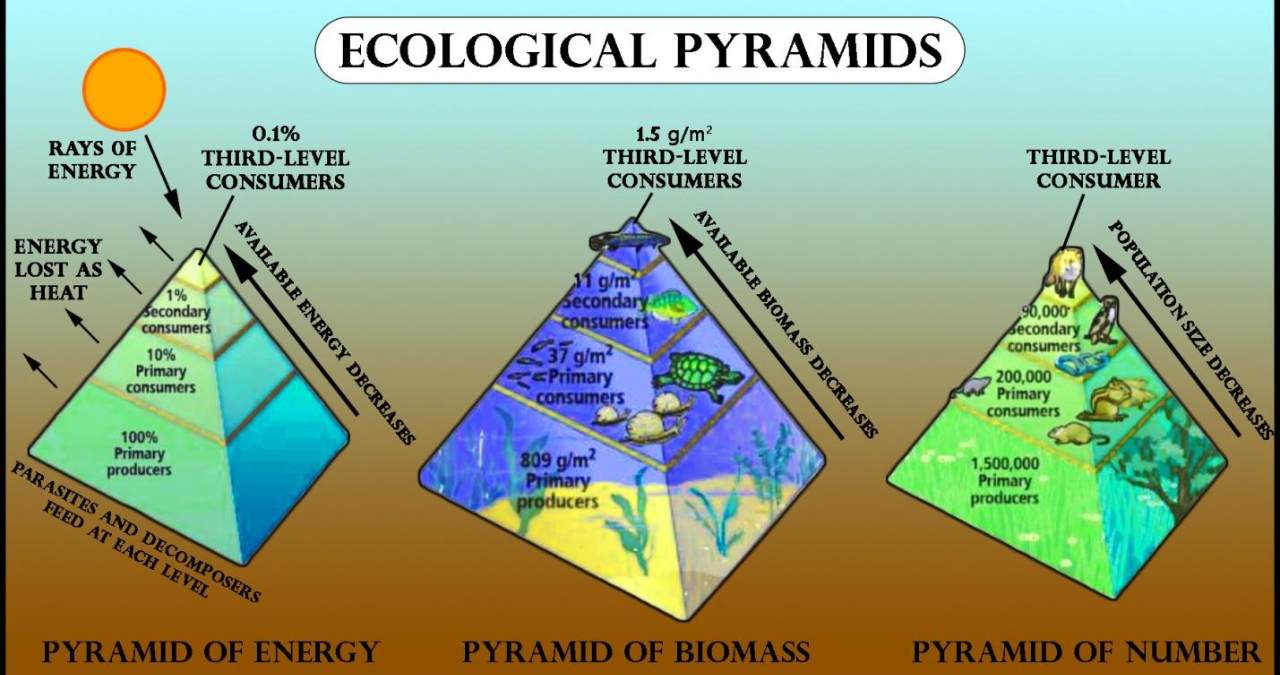Understand the energy pyramid, how energy flows through ecosystems, and why it’s vital to life on Earth. Learn about trophic levels, energy loss, real-world impacts, and conservation strategies.
The energy pyramid is one of the most crucial yet often overlooked concepts in ecology. It explains how energy moves through an ecosystem, from the smallest grass blade to the apex predator. Think of it as nature’s way of managing power and survival — it’s not just about who eats whom, but about how energy flows and diminishes with each step up the food chain.
Whether you’re a student, an environmental enthusiast, or just someone trying to wrap your head around how ecosystems function, understanding the energy pyramid offers a new perspective on life’s natural balance. In this article, we’re going to break it down layer by layer, casually yet expertly, to help you appreciate the delicate design of the natural world.
What is an Energy Pyramid?
The energy pyramid is a graphical model that illustrates the flow of energy through different levels in an ecosystem. It’s typically shaped like a pyramid because energy decreases at each successive trophic level — the base is wide with abundant energy, and the top is narrow where energy is scarce.
At the bottom, we have producers, usually plants and algae, which capture energy from the sun through photosynthesis. From there, energy moves up to primary consumers (herbivores), secondary consumers (carnivores that eat herbivores), and finally tertiary consumers (top predators). Decomposers, like fungi and bacteria, operate outside the pyramid but play an essential role in recycling nutrients.
The energy pyramid isn’t just theoretical. It has real-world applications in wildlife management, conservation, and understanding climate impact. If you want to protect nature, you’ve got to understand how energy moves through it.
The Trophic Levels Explained
Trophic levels are the layers in the energy pyramid, each representing a group of organisms that share the same function in the food chain and obtain energy in similar ways.
Producers: The Energy Foundation
Producers are the base of the energy pyramid. They include green plants, algae, and some bacteria that can perform photosynthesis. These organisms convert solar energy into chemical energy stored in glucose, which becomes the primary energy source for other living beings.
Without producers, there would be no energy entering the pyramid. They are the ultimate energy gatekeepers, turning non-living solar power into something usable for life. That’s why plant-rich ecosystems, like rainforests, are so productive — they have more energy to go around.
Primary Consumers: The Herbivores
These are the animals that feed on producers. Think cows, deer, rabbits, caterpillars — basically, any animal that eats plants. They get their energy directly from the plants and pass it along when they’re consumed by the next level.
Even though herbivores eat energy-rich plants, they only retain a small fraction of that energy. Most of it is used for their own metabolism, movement, and heat. That’s why there’s less energy available as you move up the pyramid.
Secondary Consumers: The Carnivores
Secondary consumers eat the herbivores. These are your snakes, foxes, and birds that love a good insect meal. By the time energy reaches them, only about 10% of the energy from the producers remains.
The energy loss here is substantial. Every time you go up a level, about 90% of the energy is lost, mostly as heat. That’s the real reason carnivores are fewer in number — the pyramid simply can’t support too many of them.
Tertiary Consumers: The Apex Predators
These are the kings and queens of the jungle — lions, eagles, sharks, and humans in many ecosystems. They sit at the top of the energy pyramid and have no natural predators of their own.
Tertiary consumers depend on a vast and energy-rich base to survive. Because energy is so limited at this level, the populations of apex predators are typically small and their survival is more vulnerable to disruptions in the ecosystem.
Energy Transfer Efficiency in the Pyramid
One of the most important concepts to understand about the energy pyramid is that energy transfer is not efficient. Only about 10% of the energy from one level is transferred to the next — this is called the 10% Rule.
This inefficiency explains why there are fewer animals as you go up the pyramid. It also means that producing plant-based food is far more energy-efficient than meat-based food. For instance, growing a field of wheat to feed humans directly requires much less energy than feeding it to cows first.
Another big factor is metabolism. Every organism uses energy to maintain its bodily functions. From breathing to reproducing to running from predators — all of that burns through energy that doesn’t get passed on to the next level.
Real-World Applications of the Energy Pyramid
Understanding the energy pyramid has some powerful real-world implications. For example, conservationists use this model to predict how ecosystems might react to the loss or reintroduction of species.
It also matters in agriculture and food policy. By understanding where energy is being lost, we can make better decisions about sustainable food production. Plant-based diets, for example, are more efficient because they rely more on the pyramid’s base.
Fisheries management also depends heavily on energy pyramid concepts. Overfishing apex predators, like tuna, can cause massive ripple effects throughout the marine food chain. By understanding where species sit in the pyramid, we can manage them more responsibly.
Human Impact on the Energy Pyramid
Humans affect the energy pyramid in many ways, often unintentionally. Deforestation, pollution, overfishing, and climate change can all disrupt the delicate energy flow in ecosystems.
When we cut down forests, we remove the producers — the very foundation of the energy pyramid. Without them, energy can’t even enter the system, and everything above suffers. Similarly, pesticides may kill herbivores, throwing off the balance between consumers and producers.
Climate change also plays a significant role. Rising temperatures can change metabolic rates, alter food availability, and shift species distributions. All of this shakes up the pyramid, sometimes in unpredictable ways.
Why the Energy Pyramid is Always a Pyramid
You might wonder: could an energy pyramid ever be shaped differently — maybe a rectangle or even an inverted triangle? The answer is no, and here’s why.
Because of the energy loss at each level, there’s simply not enough energy to support the same number of organisms as you move up. If you had more top predators than producers, the system would collapse. The pyramid shape reflects the laws of thermodynamics — specifically, the second law, which states that energy tends to disperse.
Even in aquatic ecosystems, where biomass pyramids might be inverted due to fast-reproducing algae, the energy pyramid remains upright. That’s because energy still flows in the same direction and gets lost at every step.
The Role of Decomposers in the Energy Pyramid

While decomposers don’t appear in the classic energy pyramid, they’re absolutely essential. They break down dead organisms and recycle nutrients back into the soil, where producers can use them again.
Fungi, bacteria, and scavengers like vultures help keep ecosystems clean and sustainable. They’re like nature’s janitors, ensuring that energy and matter don’t go to waste.
Decomposers also return energy to the environment in the form of heat and nutrients. So even though they operate outside the main pyramid, they’re still part of the overall energy flow.
Table: Summary of Trophic Levels in the Energy Pyramid
| Trophic Level | Examples | Energy Source |
|---|---|---|
| Producers | Plants, algae | Sunlight |
| Primary Consumers | Rabbits, insects, deer | Producers |
| Secondary Consumers | Snakes, frogs, small birds | Primary consumers |
| Tertiary Consumers | Lions, eagles, sharks | Secondary consumers |
| Decomposers | Bacteria, fungi, scavengers | Dead organisms (outside main pyramid) |
Quotes on Energy Flow in Nature
“In nature, nothing exists alone.” — Rachel Carson
“Energy cannot be created or destroyed, it can only be changed from one form to another.” — Albert Einstein
“Everything is connected. The energy pyramid reminds us that all life is linked in a delicate web.” — Unknown
FAQs on Energy Pyramid
Q: What is an energy pyramid?
A: It’s a visual model that shows how energy flows through an ecosystem across different trophic levels.
Q: Why does energy decrease at each level?
A: Most energy is used by organisms for life processes or lost as heat, so only about 10% is passed to the next level.
Q: Are humans part of the energy pyramid?
A: Yes, humans can be both primary and tertiary consumers, depending on their diet.
Q: What happens if one level of the pyramid collapses?
A: It disrupts the entire system. Removing one level affects all others due to their energy dependence.
Q: Can an energy pyramid ever be inverted?
A: No. While biomass pyramids can be inverted in aquatic systems, energy pyramids always retain the pyramid shape due to energy loss.
Q: Why are decomposers not in the pyramid?
A: They operate outside the main pyramid but are essential for recycling nutrients and maintaining energy flow.
Q: How can we protect the energy pyramid?
A: By conserving producers, limiting pollution, practicing sustainable agriculture, and preserving ecosystems.
Conclusion: Nature’s Power Hierarchy
The energy pyramid isn’t just a concept in a textbook — it’s the blueprint of every ecosystem. It helps us understand why some animals are rare, why plants are essential, and why everything in nature is connected. By grasping how energy moves through the pyramid, we can make smarter choices about food, conservation, and our impact on the planet. Protecting the base of the pyramid means protecting everything above it — and in the end, that includes us too.

